Petrogenesis of the Early Cretaceous Aolunhua Adakitic Monzogranite Porphyries, Southern Great Xing’an Range, NE China: Implication for Geodynamic Setting of Mo Mineralization
Abstract
1. Introduction
2. Regional Geological Setting
3. Sampling and Analytical Methods
3.1. Whole-Rock Major and Trace Elements
3.2. Sr–Nd Isotopes
4. Results
4.1. Major and Trace Element Geochemistry
4.2. Sr–Nd Isotope Geochemistry
5. Discussion
5.1. Characteristics of the Source Region of Early Cretaceous Adakitic Rocks in the Xilamulun District
5.2. Evolution of Adakitic Magma
5.3. Geodynamic Setting for Mo Mineralization During Early Cretaceous Period
6. Conclusions
- (1)
- The Aolunhua monzogranite porphyries in the Xilamulun district are characterized by high Sr and Sr/Y, low Y and HREE abundances, without significantly negative Eu anomalies and the depletion of HFSEs (e.g., Nb, Ta, and Ti), typically characteristic of adakites. The characteristics of high (87Sr/86Sr)i and negative εNd(t) with young two-stage Nd model ages (T2DM = 0.84–1.16 Ga) suggest that they were derived from a dominantly juvenile mafic lower crustal source with minor involvement of mantle-derived mafic magma, which is also evidenced by high K2O/Na2O, low CaO/Al2O3.
- (2)
- Positive correlation between La and La/Sm suggest that a partial melting process play an important role in the generation of adakitic rocks in the Xilamulun district. Incompatible trace element modeling shows that adakitic rocks in this area originated from 20%–40% partial melting of amphibolitic lower continental crust at low pressure. Low FeOT/(FeOT + MgO) values indirectly reflect these adakitic rocks were derived from an oxidizing source related to magnesian granitoids. The decreasing content of TiO2, Fe2O3, Nb/Ta ratio, and moderately negative Eu anomalies suggest that minimal fractionation of Fe–Ti oxides and plagioclase may have occurred in their evolutionary history.
- (3)
- Considering the rock assemblages and the evolutionary history in the Xilamulun district, these Early Cretaceous adakites are interpreted to be generated in an extensional setting related to lithospheric delamination.
Author Contributions
Funding
Acknowledgments
Conflicts of Interest
References
- Defant, M.J.; Drummond, M.S. Derivation of some modern arc magmas by melting of young subducted lithosphere. Nature 1990, 347, 662–665. [Google Scholar] [CrossRef]
- Breitfeld, H.T.; Macpherson, C.; Hall, R.; Thirlwall, M.; Ottley, C.J.; Hennig–Breitfeld, J. Adakites without a slab: Remelting of hydrous basalt in the crust and shallow mantle of Borneo to produce the Miocene Sintang Suite and Bau Suite magmatism of West Sarawak. Lithos 2019, 344, 100–121. [Google Scholar] [CrossRef]
- Chung, S.L.; Liu, D.; Ji, J.; Chu, M.F.; Lee, H.Y.; Wen, D.J.; Lo, C.H.; Lee, T.Y.; Qian, Q.; Zhang, Q. Adakites from continental collision zones: Melting of thickened lower crust beneath southern Tibet. Geology 2003, 31, 1021–1024. [Google Scholar] [CrossRef]
- Guo, Z.F.; Wilson, M.; Liu, J.Q. Post–collisional adakites in south Tibet: Products of partial melting of subduction–modified lower crust. Lithos 2007, 96, 205–224. [Google Scholar] [CrossRef]
- Karsli, O.; Dokuz, A.; Kandemir, R.; Aydin, F.; Schmitt, A.K.; Ersoy, E.Y.; Alyıldız, C. Adakite–like parental melt generation by partial fusion of juvenile lower crust, Sakarya Zone, NE Turkey: A far–field response to break–off of the southern Neotethyan oceanic lithosphere. Lithos 2019, 338, 58–72. [Google Scholar] [CrossRef]
- Oyarzun, R.; Marquez, A.; Lillo, J.; Lopez, I.; Rivera, S. Giant versus small porphyry copper deposits of Cenozoic age in northern Chile: Adakitic versus normal calc–alkaline magmatism. Miner. Deposita 2001, 36, 794–798. [Google Scholar] [CrossRef]
- Ahmadian, J.; Sarjoughian, F.; Lentz, D.; Esna–Ashari, A.; Murata, M.; Ozawa, H. Eocenc K–rich adakitic rocks in the Central Iran: Implications for evaluating its Cu–Au–Mo metallogenic potential. Ore Geol. Rev. 2016, 72, 323–342. [Google Scholar] [CrossRef]
- Condie, K.C. TTGs and adakites: Are they both slab melts? Lithos 2005, 80, 33–44. [Google Scholar] [CrossRef]
- Hastie, A.R.; Kerr, A.C.; McDonald, I.; Mitchell, S.F.; Pearce, J.A.; Wolstencroft, M.; Millar, I.L. Do Cenozoic analogues support a plate tectonic origin for Earth’s earliest continental crust? Geology 2010, 38, 495–498. [Google Scholar] [CrossRef]
- Castillo, P.R. Adakite petrogenesis. Lithos 2012, 134, 304–316. [Google Scholar] [CrossRef]
- Zhang, J.H.; Gao, S.; Ge, W.C.; Wu, F.Y.; Yang, J.H.; Wilde, S.A.; Li, M. Geochronology of the Mesozoic volcanic rocks in the Great Xing’an Range, northeastern China: Implications for subduction–induced delamination. Chem. Geol. 2010, 276, 144–165. [Google Scholar] [CrossRef]
- Wu, H.Y.; Zhang, L.C.; Wan, B.; Chen, Z.G.; Zhang, X.J.; Xiang, P. Geochronological and geochemical constraints on Aolunhua porphyry Mo–Cu deposit, northeast China, and its tectonic significance. Ore Geol. Rev. 2011, 43, 78–91. [Google Scholar] [CrossRef]
- Ma, X.H.; Chen, B.; Yang, M.C. Magma mixing origin for the Aolunhua porphyry related to Mo–Cu mineralization, eastern Central Asian Orogenic Belt. Gondwana Res. 2013, 24, 1152–1171. [Google Scholar] [CrossRef]
- Shu, Q.H.; Lai, Y.; Wang, C.; Xu, J.J.; Sun, Y. Geochronology, geochemistry and Sr–Nd–Hf isotopes of the Haisugou porphyry Mo deposit, northeast China, and their geological significance. J. Asian Earth Sci. 2014, 79, 777–791. [Google Scholar] [CrossRef]
- Zeng, Q.; Yang, J.; Zhang, Z.; Liu, J.; Duan, X. Petrogenesis of the Yangchang Mo–bearing granite in the Xilamulun metallogenic belt, NE China: Geochemistry, zircon U–Pb ages and Sr–Nd–Pb isotopes. Geol. J. 2014, 49, 1–14. [Google Scholar] [CrossRef]
- Zhang, X.J.; Zhang, L.C.; Qi, X.D.; Wu, H.Y.; Xiang, P.; Chen, Z.G. U–Pb ages, geochemical characteristics and their implications of Banlashan molybdenum deposit. Acta Petrol. Sinica 2010, 26, 1411–1422, (In Chinese with English abstract). [Google Scholar]
- Shu, Q.H.; Lai, Y.; Zhou, Y.T.; Xu, J.J.; Wu, H.Y. Zircon U–Pb geochronology and Sr–Nd–Pb–Hf isotopic constraints on the timing and origin of Mesozoic granitoids hosting the Mo deposits in northern Xilamulun district, NE China. Lithos 2015, 238, 64–75. [Google Scholar] [CrossRef]
- Zhou, Z.H.; Mao, J.W.; Lyckberg, P. Geochronology and isotopic geochemistry of the A–type granites from the Huanggang Sn–Fe deposit, southern Great Hinggan Range, NE China: Implication for their origin and tectonic setting. J. Asian Earth Sci. 2012, 49, 272–286. [Google Scholar] [CrossRef]
- Qin, F.; Liu, J.M.; Zeng, Q.D.; Luo, Z.H. Petrogenetic and metallogenic machenism of the Xiaodonggou porphyry molybdenum deposit in Hexiten Banner, Inner Mongolia. Acta Petrol. Sinica 2009, 25, 3357–3368, (In Chinese with English abstract). [Google Scholar]
- Wang, F.; Zhou, X.H.; Zhang, L.C.; Ying, J.F.; Zhang, Y.T.; Wu, F.Y.; Zhu, R.X. Late Mesozoic volcanism in the Great Xing’an Range (NE China): Timing and implications for the dynamic setting of NE Asia. Earth Planet. Sci. Lett. 2006, 251, 179–198. [Google Scholar] [CrossRef]
- Ouyang, H.G.; Mao, J.W.; Santosh, M.; Wu, Y.; Hou, L.; Wang, X.F. The Early Cretaceous Weilasituo Zn–Cu–Ag vein deposit in the southern Great Xing’an Range, northeast China: Fluid inclusions, H, O, S, Pb isotope geochemistry and genetic implications. Ore Geol. Rev. 2014, 56, 503–515. [Google Scholar] [CrossRef]
- Zhou, Z.H.; Mao, J.W.; Wu, X.L.; Ouyang, H.G. Geochronology and geochemistry constraints of the early Cretaceous Taibudai porphyry Cu deposit, northeast China, and its tectonic significance. J. Asian Earth Sci. 2015, 103, 212–228. [Google Scholar] [CrossRef]
- Zeng, Q.; Liu, J.; Zhang, Z.; Chen, W.; Zhang, W. Geology and geochronology of the Xilamulun molybdenum metallogenic belt in eastern Inner Mongolia, China. Int. J. Earth Sci. 2011, 100, 1791–1809. [Google Scholar] [CrossRef]
- Zhou, Z.H.; Mao, J.W.; Liu, J.; Ouyang, H.G.; Che, H.W.; Ma, X.H. Early Cretaceous magmatism and ore mineralization in Northeast China: Examples from Taolaituo Mo and Aobaotu Pb–Zn deposits. Int. Geol. Rev. 2015, 57, 229–256. [Google Scholar] [CrossRef]
- Liu, Z.; Huang, X.K.; Zhu, X.Y.; Jiang, B.B.; Xu, Q.; Wei, W.; Zhang, Z.Q.; Peng, Q.S. Chronology of U–Pb zircon and geochemistry of the biotite monzogranite and its geological implication of the north Xiaojingzi copper–molybdenum deposit in Inner Mengolia. Miner. Explor. 2017, 8, 997–1009, (In Chinese with English abstract). [Google Scholar]
- Zhao, Z.H.; Sun, J.G.; Li, G.H.; Xu, W.X.; Lü, C.L.; Wu, S.; Guo, Y.; Ren, L.; Hu, Z.X.; Tang, L. Age of the Yongxin Au deposit in the Lesser Xing’an Range: Implications for an Early Cretaceous geodynamic setting for gold mineralization in NE China. Geol. J. 2019, 54, 2525–2544. [Google Scholar] [CrossRef]
- Liu, Y.S.; Zong, K.Q.; Kelemen, P.B.; Gao, S. Geochemistry and magmatic history of eclogites and ultramafic rocks from the Chinese continental scientific drill hole: Subduction and ultrahigh-pressure metamorphism of lower crustal cumulates. Chem. Geol. 2008, 247, 133–153. [Google Scholar] [CrossRef]
- Li, C.F.; Li, X.H.; Li, Q.L.; Guo, J.H.; Yang, Y.H. Rapid and precise determination of Sr and Nd isotopic ratios in geological samples from the same filament loading by thermal ionization mass spectrometry employing a single-step separation scheme. Anay. Chim. Acta 2012, 727, 54–60. [Google Scholar] [CrossRef]
- Tanaka, T.; Togashi, S.; Kamioka, H.; Amakawa, H.; Kagami, H.; Hamamoto, T.; Yuhara, M.; Orihashi, Y.; Yoneda, S.; Shimizu, H.; et al. JNdi–1: A neodymium isotopic reference in consistency with LaJolla neodymium. Chem. Geol. 2000, 168, 279–281. [Google Scholar] [CrossRef]
- Weis, D.; Kieffer, B.; Maerschalk, C.; Barling, J.; de Jong, J.; Williams, G.A.; Hanano, D.; Pretorius, W.; Mattielli, N.; Scoates, J.S.; et al. High–precision isotopic characterization of USGS reference materials by TIMS and MC–ICP–MS. Geochem. Geophy. Geosy. 2006, 7, Q08006. [Google Scholar] [CrossRef]
- Karsli, O.; Dokuz, A.; Uysal, I.; Aydin, F.; Kandemir, R.; Wijbrans, R.J. Generation of the early Cenozoic adakitic volcanism by partial melting of mafic lower crust, Eastern Turkey: Implications for crustal thickening to delamination. Lithos 2010, 114, 109–120. [Google Scholar] [CrossRef]
- Dokuz, A.; Uysal, I.; Meisel, W.; Turan, M.; Duncan, R.; Akçay, M. Post-collisional adakitic volcanism in the eastern part of the Sakarya Zone, Turkey: Evidence for slab and crustal melting. Contrib. Mineral. Petr. 2013, 166, 1443–1468. [Google Scholar] [CrossRef]
- Ding, H.; Wu, J.H.; Zhu, H.T.; Wu, R.G.; Yu, D.J. SHRIMP zircon U–Pb dating and geochemistry characteristics of granite–porphyries from Hongshanzi basin and its geological significance in south Great Hingan Range. J. East China Univ. Technol. Nat. Sci. 2016, 39, 1–9, (In Chinese with English abstract). [Google Scholar]
- Sun, S.S.; McDonough, W.F. Chemical and isotopic systematics of oceanic basalts: Implications for mantle composition and processes. Geol. Soc. Lond. Spec. Publ. 1989, 42, 313–345. [Google Scholar] [CrossRef]
- Boynton, W.V. Geochemistry of the rare earth elements: Meteorite studies. In Rare Earth Element Geochemistry; Henderson, P., Ed.; Elsevier: New York, NY, USA, 1984; pp. 63–114. [Google Scholar]
- Foley, S.; Tiepolo, M.; Vannucci, R. Growth of early continental crust controlled by melting of amphibolite in subduction zones. Nature 2002, 417, 837–840. [Google Scholar] [CrossRef] [PubMed]
- Kamei, A.; Miyake, Y.; Owada, M.; Kimura, J.I. A pseudo adakite derived from partial melting of tonalitic to granodioritic crust, Kyushu, southwest Japan arc. Lithos 2009, 112, 615–625. [Google Scholar] [CrossRef]
- Kay, S.M.; Ramos, V.A.; Marquez, M. Evidence in Cerro Pampa volcanic rocks of slab melting prior to ridge trench collision in southern South America. J. Geol. 1993, 101, 703–714. [Google Scholar] [CrossRef]
- Stern, C.R.; Kilian, R. Role of the subducted slab, mantle wedge and continental crust in the generation of adakites from the Andean Austral volcanic zone. Contrib. Mineral. Petr. 1996, 123, 263–281. [Google Scholar] [CrossRef]
- Yogodzinski, G.M.; Kay, R.W.; Volynets, O.N.; Koloskov, A.V.; Kay, S.M. Magnesian andesite in the western Aleutian Komandorsky region: Implications for slab melting and processes in the mantle wedge. Geol. Soc. Am. Bull. 1995, 107, 505–519. [Google Scholar] [CrossRef]
- Guan, Q.; Zhu, D.C.; Zhao, Z.D.; Dong, G.C.; Zhang, L.L.; Li, X.W.; Liu, M.; Mo, X.X.; Liu, Y.S.; Yuan, H.L. Crustal thickening prior to 38 Ma in southern Tibet: Evidence from lower crust–derived adakitic magmatism in the Gangdese batholith. Gondwana Res. 2012, 21, 88–99. [Google Scholar] [CrossRef]
- Rapp, R.P.; Shimizu, N.; Norman, M.D.; Applegate, G.S. Reaction between slab–derived melts and peridotite in the mantle wedge: Experimental constraints at 3.8 GPa. Chem. Geol. 1999, 160, 335–356. [Google Scholar] [CrossRef]
- Wang, Q.; Xu, J.F.; Jian, P.; Bao, Z.W.; Zhao, Z.H.; Li, C.F.; Xiong, X.L.; Ma, J.L. Petrogenesis of adakitic porphyries in an extensional Tectonic setting, Dexing, South China: Implications for the genesis of porphyry copper mineralization. J. Petrol. 2006, 47, 119–144. [Google Scholar] [CrossRef]
- Wang, Q.; Xu, J.F.; Zhao, Z.H.; Bao, Z.W.; Xu, W.; Xiong, X.L. Cretaceous high–potassium intrusive rocks in the Yueshan–Hongzhen area of east China: Adakites in an extensional tectonic regime within a continent. Geochem. J. 2004, 38, 417–434. [Google Scholar] [CrossRef]
- Xu, J.F.; Shinjo, R.; Defant, M.J.; Wang, Q.; Rapp, R.P. Origin of Mesozoic adakitic intrusive rocks in the Ningzhen area of East China: Partial melting of delaminated lower continental crust. Geology 2002, 30, 1111–1114. [Google Scholar] [CrossRef]
- DePaolo, D.J. Nd isotopic studies: Some new perspectives on Earth structure and evolution. Eos Trans. Am. Geophys. Union 1981, 62, 137. [Google Scholar] [CrossRef]
- Watson, B.E.; Harrison, M.T. Zircon saturation revisited: Temperature and composition effects in a variety of crustal magma types. Earth Planet. Sci. Lett. 1983, 64, 295–304. [Google Scholar] [CrossRef]
- Steiger, R.H.; Jäer, E. Subcommission on geochronology: Convention on the use of decay constants in geo- and cosmochronology. Earth Planet. Sci. Lett. 1977, 36, 359–362. [Google Scholar] [CrossRef]
- Lugmair, G.W.; Marti, K. Lunar initial 143Nd/144Nd: Differential evolution of the lunar crust and mantle. Earth Planet. Sci. Lett. 1978, 39, 349–357. [Google Scholar] [CrossRef]
- Jahn, B.M.; Wu, F.Y.; Lo, C.H.; Tsai, C.H. Crust–mantle interaction induced by deep subduction of the continental crust: Geochemical and Sr–Nd isotopic evidence from post-collisional mafic–ultramafic intrusions of the northern Dabie complex, central China. Chem. Geol. 1999, 157, 119–146. [Google Scholar] [CrossRef]
- Qian, Q.; Hermann, J. Partial melting of lower crust at 10–15 kbar: Constraints on adakite and TTG formation. Contrib. Mineral. Petrol. 2013, 165, 1195–1224. [Google Scholar] [CrossRef]
- Ma, Q.; Zheng, J.P.; Xu, Y.G.; Griffin, W.L.; Zhang, R.S. Are continental “adakites” derived from thickened or foundered lower crust? Earth Planet. Sci. Lett. 2015, 419, 125–133. [Google Scholar] [CrossRef]
- Hawkesworth, C.J.; Gallagher, K.; Hergt, J.M.; Mcdermott, F. Mantle and slab contributions in arc magmas. Annu. Rev. Earth Planet. Sci. 1993, 21, 175–204. [Google Scholar] [CrossRef]
- Hofmann, A.W. Mantle geochemistry: The message from oceanic volcanism. Nature 1997, 385, 219–229. [Google Scholar] [CrossRef]
- Rapp, R.P.; Watson, E.B. Dehydration melting of metabasalt at 8–32Kbar: Implications for continental growth and crust–mantle recycling. J. Petrol. 1995, 36, 891–931. [Google Scholar] [CrossRef]
- Zhang, L.C.; Zhou, X.H.; Ying, J.F.; Wang, F.; Guo, F.; Wan, B.; Chen, Z.G. Geochemistry and Sr–Nd–Pb–Hf isotopes of early Cretaceous basalts from the Great Xing’an Range, NE China: Implications for their origin and mantle source characteristics. Chem. Geol. 2008, 256, 12–23. [Google Scholar] [CrossRef]
- Rodriguez, C.; Selles, D.; Dungan, M.; Langmuir, C.; Leeman, W. Adakitic dacites formed by intracrustal crystal fractionation of water–rich parent magmas at Nevado de Longav volcano (36.2 degrees S.; Andean Southern Volcanic Zone, central Chile). J. Petrol. 2007, 48, 2033–2061. [Google Scholar] [CrossRef]
- Dai, H.K.; Zheng, J.P.; Zhou, X.; Griffin, W.L. Generation of continental adakitic rocks: Crystallization modeling with variable bulk partition coefficients. Lithos 2017, 272, 222–231. [Google Scholar] [CrossRef]
- Castillo, P.R. An overview of adakite petrogenesis. Chin. Sci. Bull. 2006, 51, 258–268. [Google Scholar] [CrossRef]
- Adam, J.; Green, T. Trace element partitioning between mica—And amphibole–bearing garnet lherzolite and hydrous basanitic melt: 1. Experimental results and the investigation of controls on partitioning behaviour. Contrib. Mineral. Petrol. 2006, 152, 1–17. [Google Scholar] [CrossRef]
- Ballouard, C.; Poujol, M.; Boulvais, P.; Branquet, Y.; Tartèse, R.; Vigneresse, J.L. Nb–Ta fractionation in peraluminous granites: A marker of the magmatic–hydrothermal transition. Geology 2016, 44, 231–234. [Google Scholar] [CrossRef]
- Dostal, J.; Kontak, D.J.; Gerel, O.; Gregory, S.J.; Fayek, M. Cretaceous ongonites (topaz–bearing albite–rich microleucogranites) from Ongon Khairkhan, Central Mongolia: Products of extreme magmatic fractionation and pervasive metasomatic fluid: Rock interaction. Lithos 2015, 236, 173–189. [Google Scholar] [CrossRef]
- Wedepohl, K.H. The composition of the continental crust. Geochim. Cosmochim. Acta 1995, 59, 1217–1232. [Google Scholar] [CrossRef]
- Münker, C.; Pfänder, J.A.; Weyer, S.; Buchl, A.; Kleine, T.; Mezger, K. Evolution of planetary cores and the earth-moon system from Nb/Ta systemtics. Science 2003, 301, 84–87. [Google Scholar] [CrossRef] [PubMed]
- Frost, B.R.; Barnes, C.G.; Collins, W.J.; Arculus, R.J.; Ellis, D.J.; Frost, C.D. A geochemical classification for granitic rocks. J. Petrol. 2001, 42, 2033–2048. [Google Scholar] [CrossRef]
- Zhang, X.J.; Lentz, D.R.; Yao, C.L.; Liu, R.; Yang, Z.; Mei, Y.X.; Fan, X.W.; Huang, F.; Qin, Y.; Zhang, K.; et al. Geochronology, geochemistry, and Sr–Nd–Pb–Hf isotopes of the Zhunsujihua granitoid intrusions associated with the molybdenum deposit, northern Inner Mongolia, China: Implications for petrogenesis and tectonic setting. Int. J. Earth Sci. 2018, 107, 687–710. [Google Scholar] [CrossRef]
- Sun, W.D.; Zhang, H.; Ling, M.X.; Ding, X.; Chung, S.L.; Zhou, J.B.; Yang, X.Y.; Fan, W.M. The genetic association of adakites and Cu-Au ore deposits. Int. Geol. Rev. 2011, 53, 691–703. [Google Scholar] [CrossRef]
- Taylor, R.D.; Hammarstrom, J.M.; Piatak, N.M.; Seal, R.R.I. Arc-Related Porphyry Molybdenum Deposit Model; U.S. Geological Survey: Reston, VA, USA, 2012; p. 64. [Google Scholar]
- Mckenzie, D.; Onions, R.K. Partial Melt Distributions from Inversion of Rare–Earth Element Concentrations. J. Petrol. 1991, 32, 1021–1091. [Google Scholar] [CrossRef]
- Taylor, S.R.; McLennan, S.M. The Continental Crust: Its Composition and Evolution; Blackwell: Oxford, UK, 1985. [Google Scholar]
- Kelemen, P.B.; Hanghoj, K.; Greene, A.R. One view of the geochemistry of subduction–related magmatic arcs, with an emphasis on primitive andesite and lower crust. In Treatise on Geochemistry; Holland, H.D., Turekian, K.K., Eds.; Elsevier: Amsterdam, The Netherlands, 2004; Volume 3, pp. 593–659. [Google Scholar]
- Whalen, J.B.; Currie, K.L.; Chappell, B.W. A-type granite: Geochemical characteristics, discrimination and petrogenesis. Contrib. Mineral. Petrol. 1987, 95, 407–419. [Google Scholar] [CrossRef]
- Zhang, J.H.; Ge, W.C.; Wu, F.Y.; Wilde, S.A.; Yang, J.H.; Liu, X.M. Large–scale early cretaceous volcanic events in the northern Great Xing’an Range, northeastern China. Lithos 2008, 102, 138–157. [Google Scholar] [CrossRef]
- Xu, W.L.; Pei, F.P.; Wang, F.; Meng, E.; Ji, W.Q.; Yang, D.B.; Wang, W. Spatial–temporal relationships of Mesozoic volcanic rocks in NE China: Constraints on tectonic overprinting and transformations between multiple tectonic regimes. J. Asian Earth Sci. 2013, 74, 167–193. [Google Scholar] [CrossRef]
- Tang, J.; Xu, W.L.; Wang, F.; Zhao, S.; Li, Y. Geochronology, geochemistry, and deformation history of late Jurassic–early Cretaceous intrusive rocks in the Erguna Massif, NE China: Constraints on the late Mesozoic tectonic evolution of the Mongol–Okhotsk orogenic belt. Tectonophysics 2015, 658, 91–110. [Google Scholar] [CrossRef]
- Wu, F.Y.; Lin, J.Q.; Wilde, S.A.; Zhang, X.O.; Yang, J.H. Nature and significance of the early Cretaceous giant igneous event in eastern China. Earth Planet. Sci. Lett. 2005, 233, 103–119. [Google Scholar] [CrossRef]
- Ouyang, H.G.; Mao, J.W.; Hu, R.Z. Geochemistry and crystallization conditions of magmas related to porphyry Mo mineralization in Northeastern China. Econ. Geol. 2020, 115, 79–100. [Google Scholar] [CrossRef]

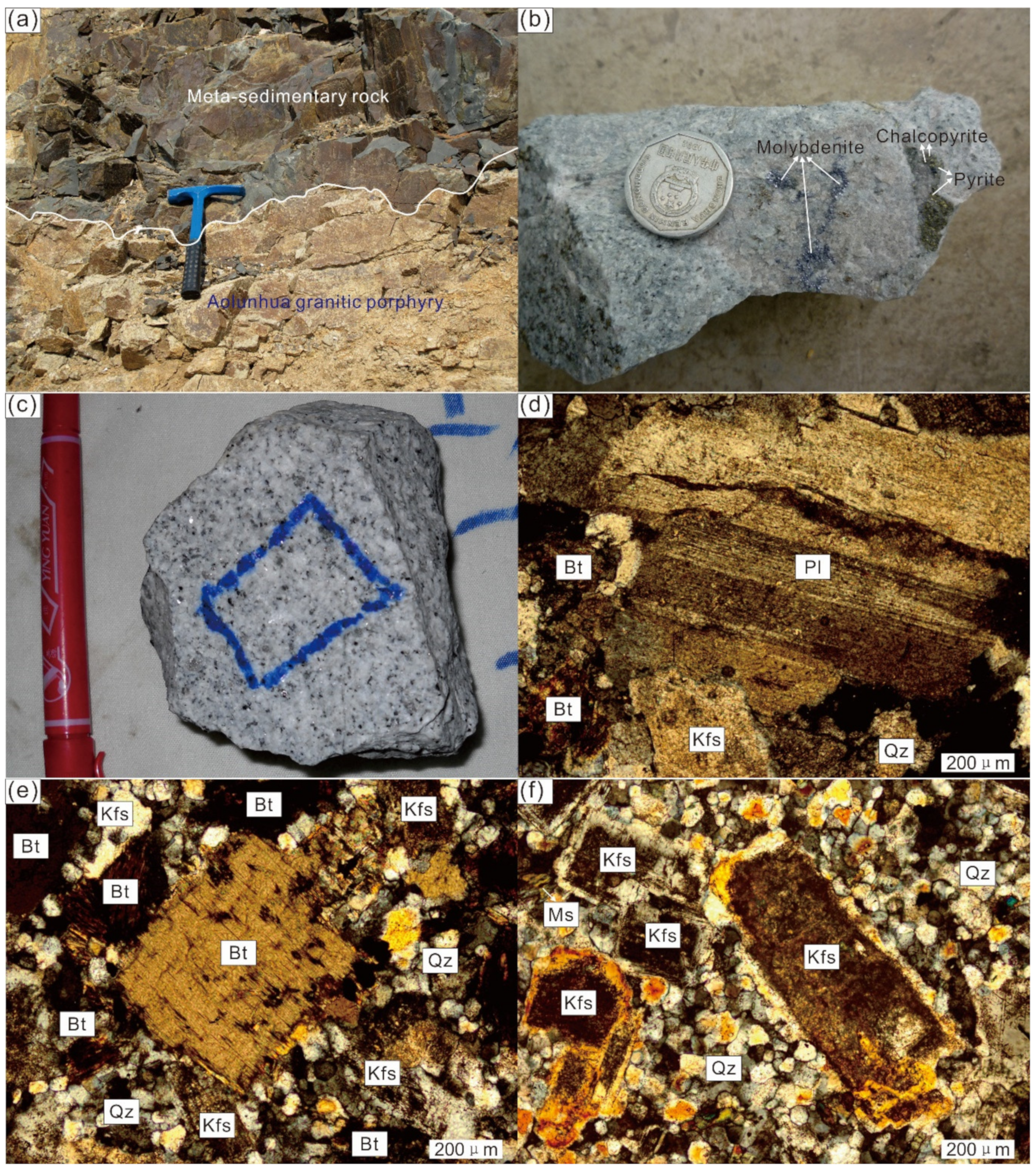
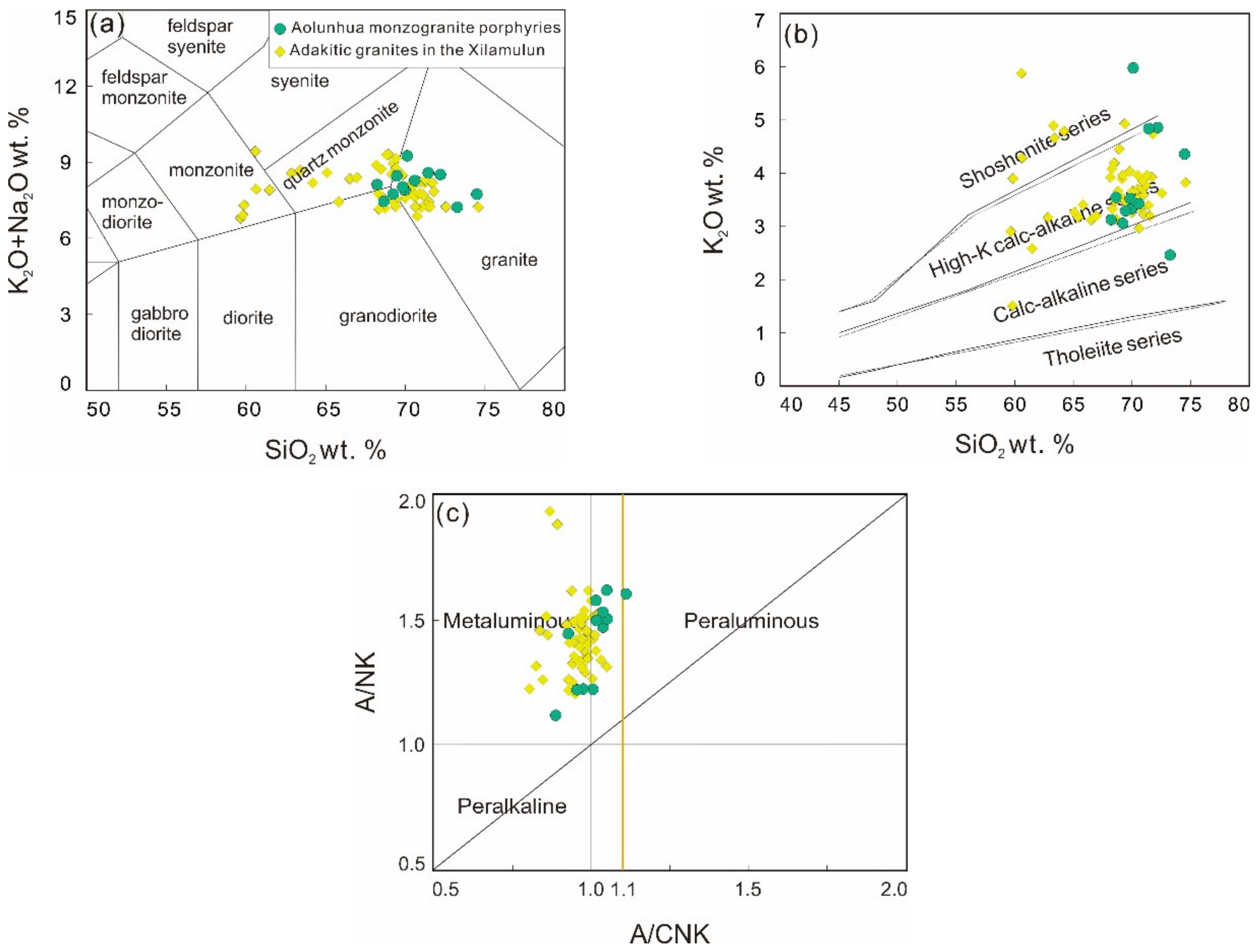
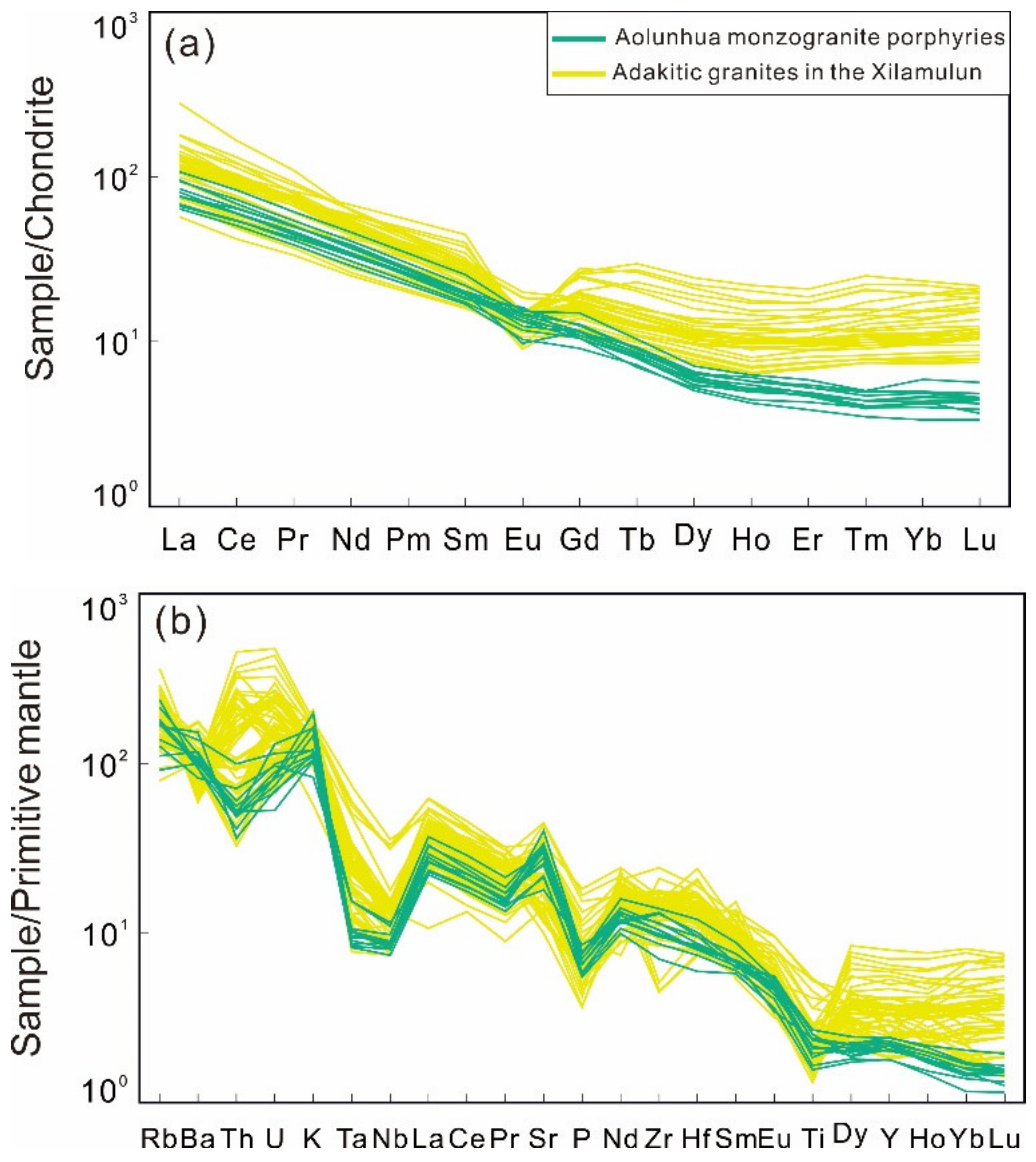
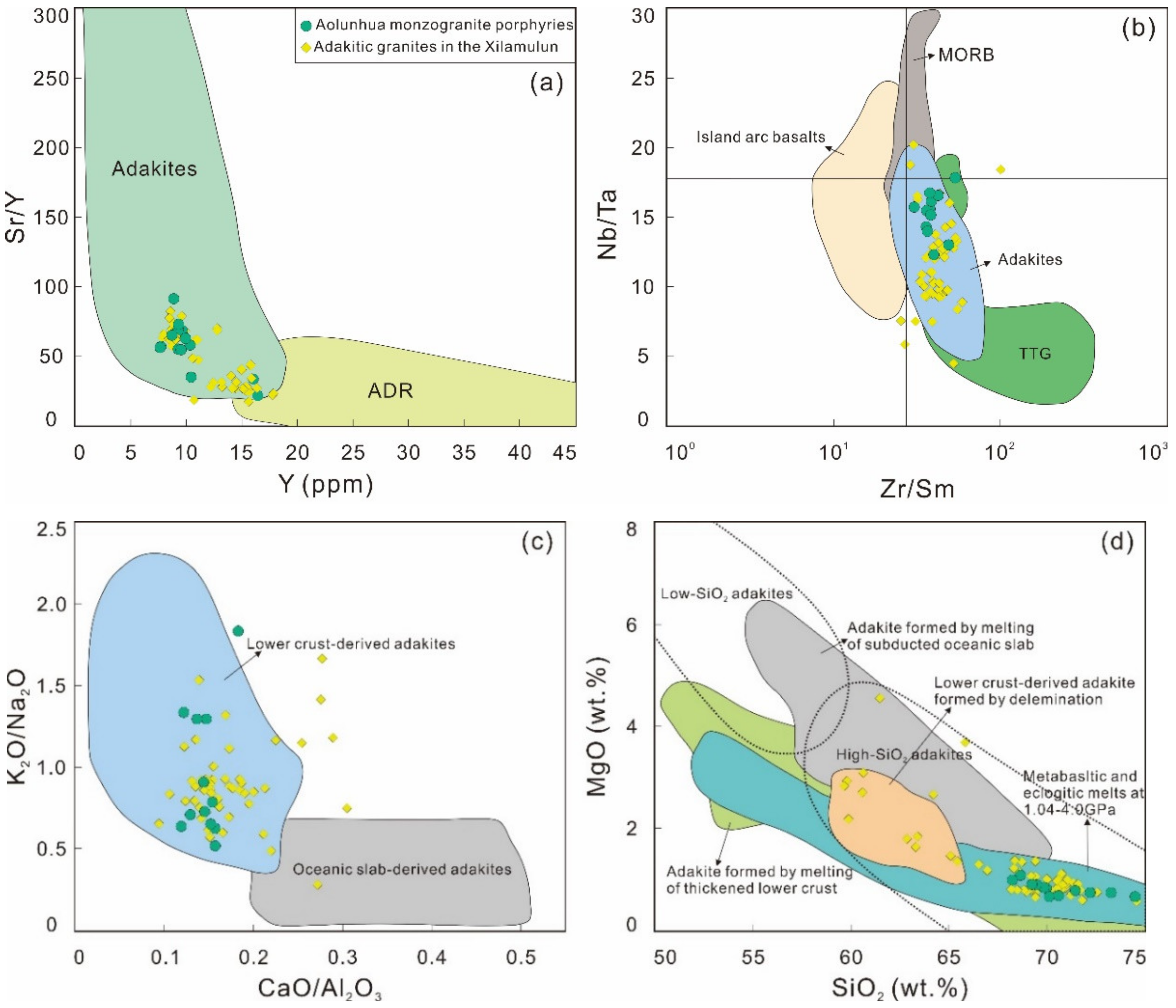
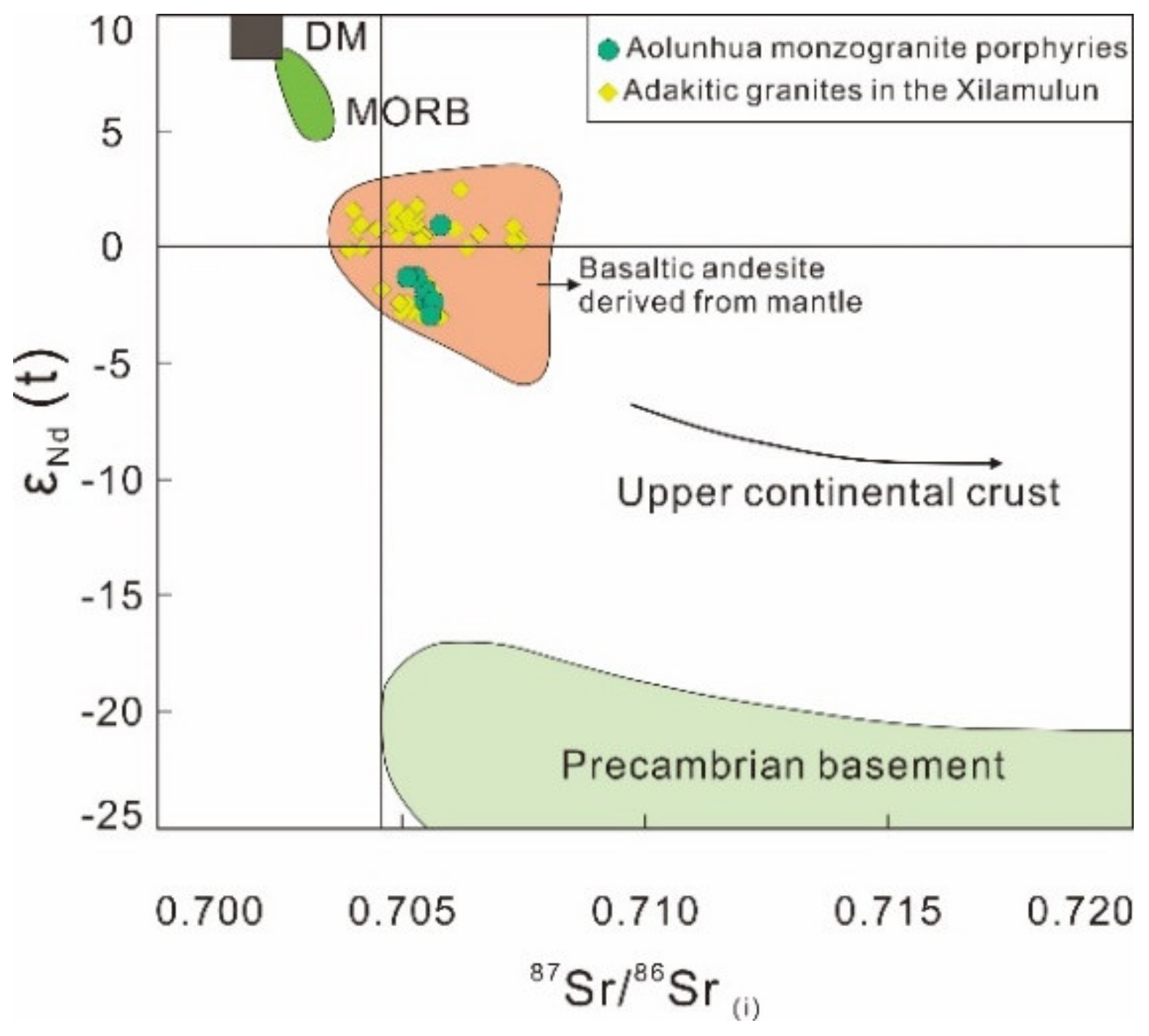
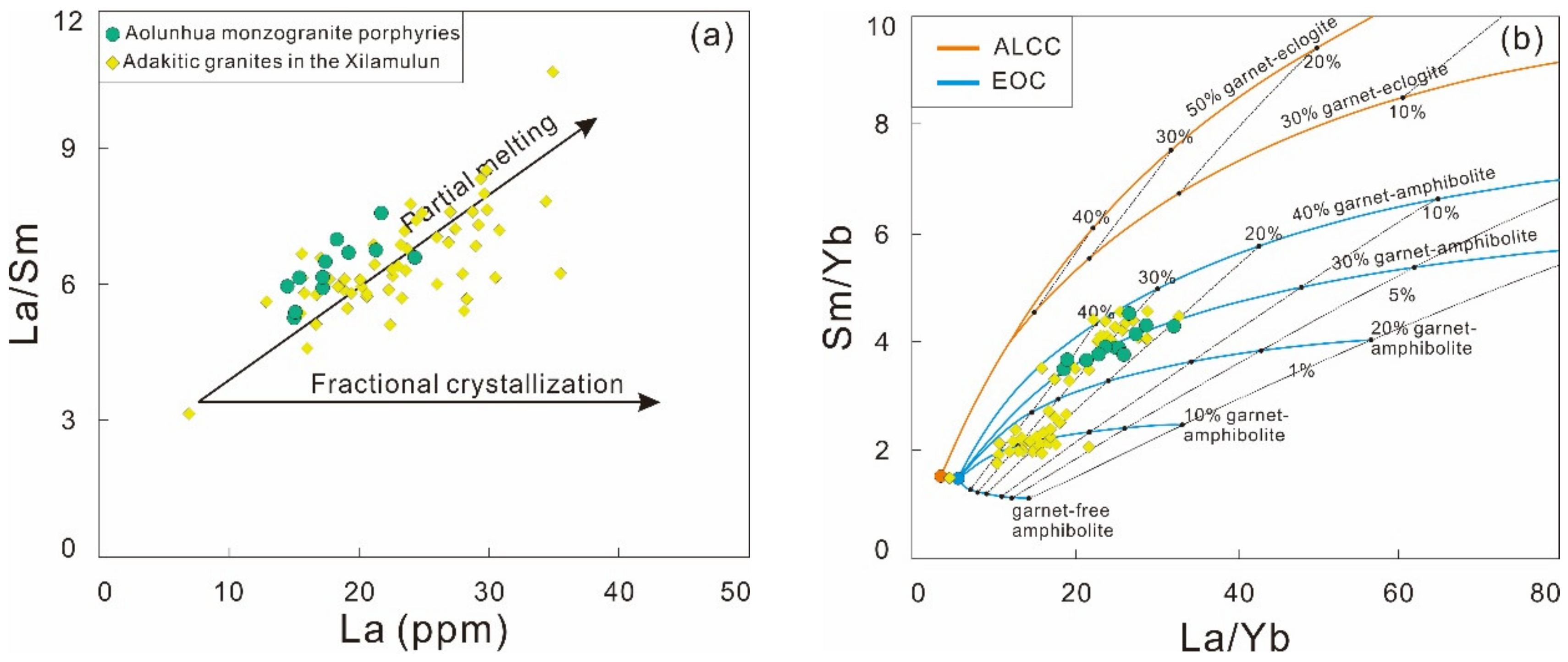
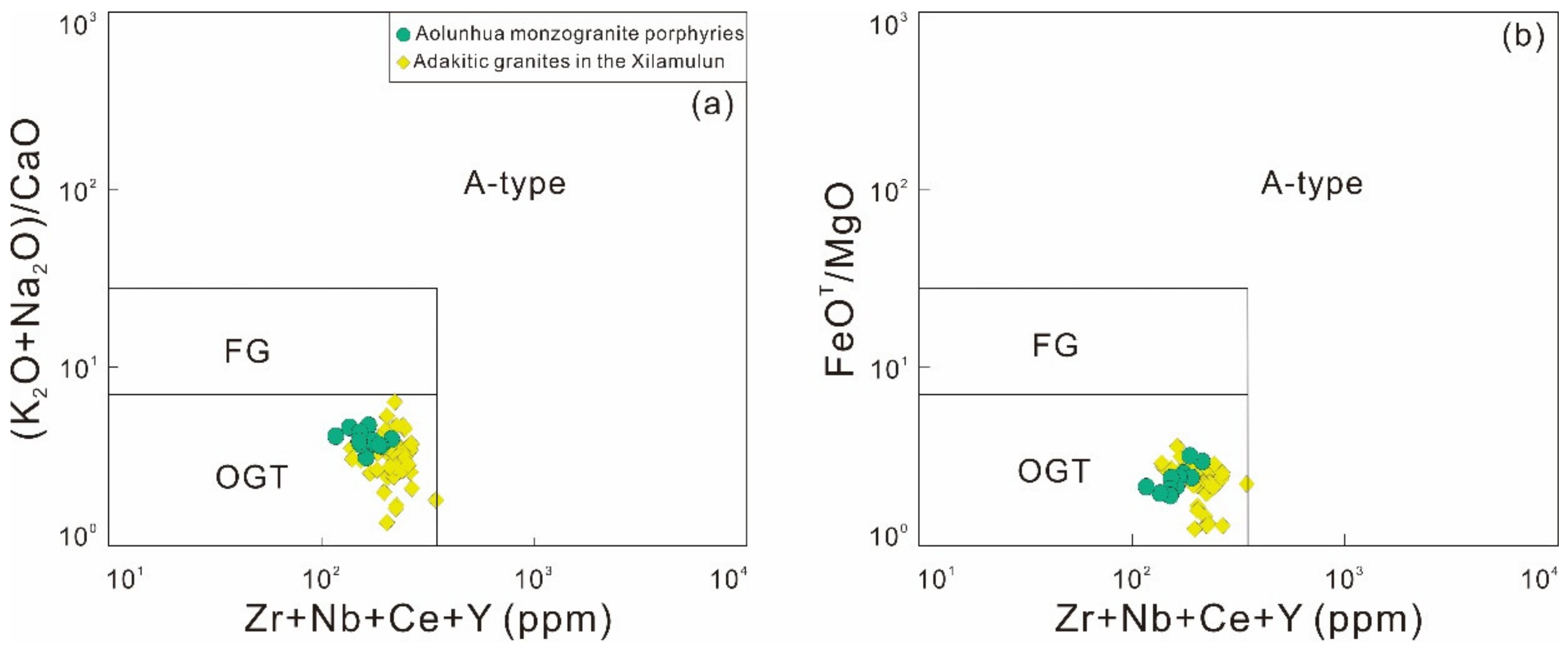
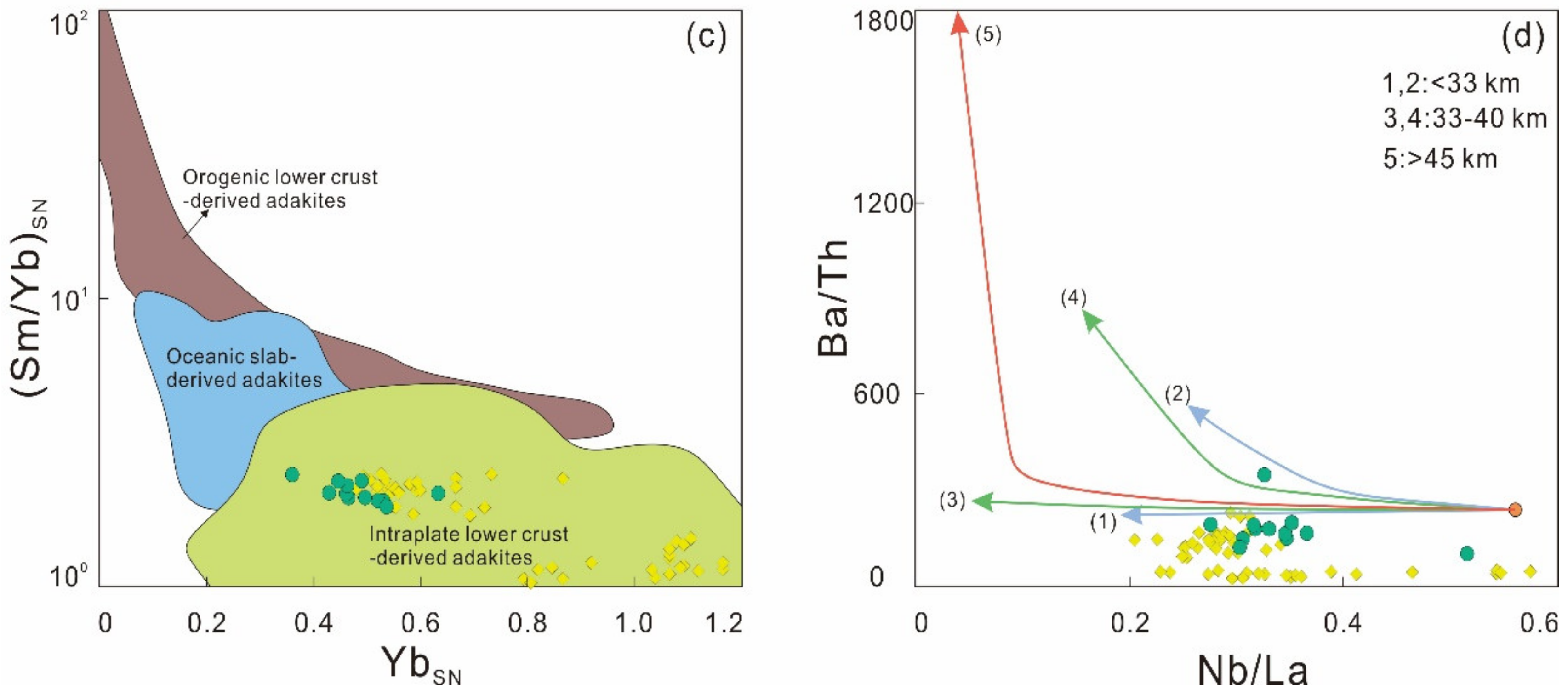
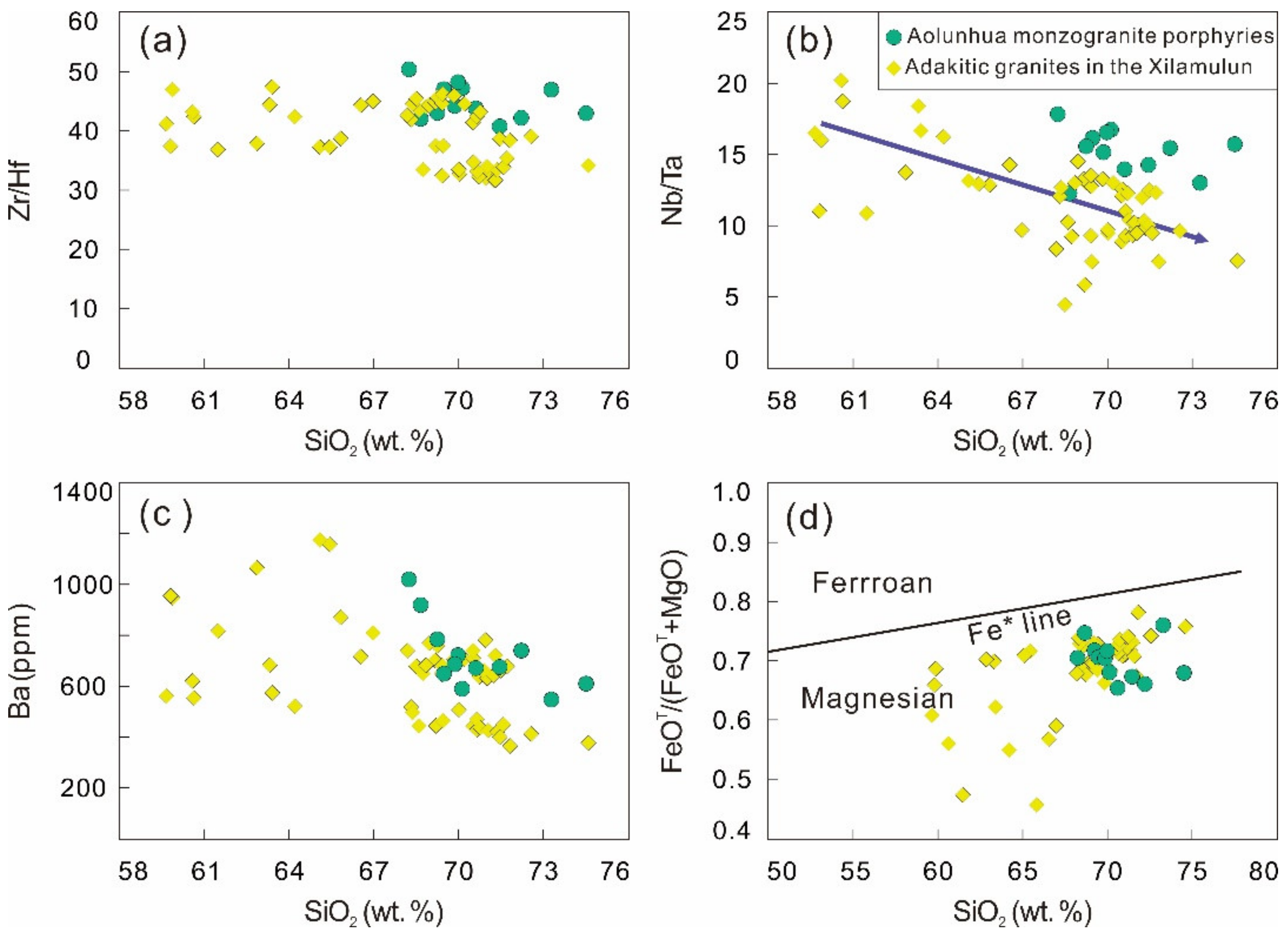
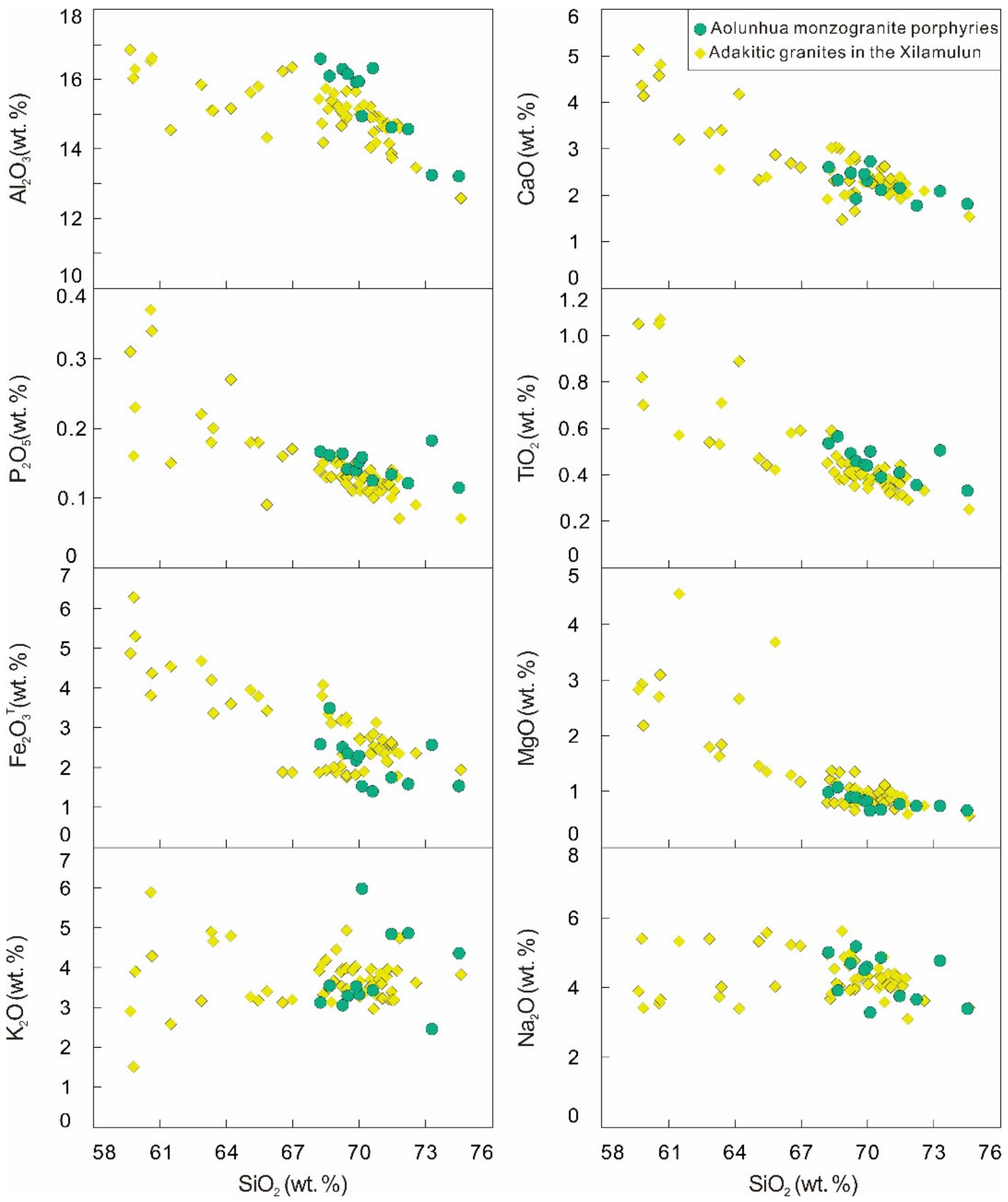
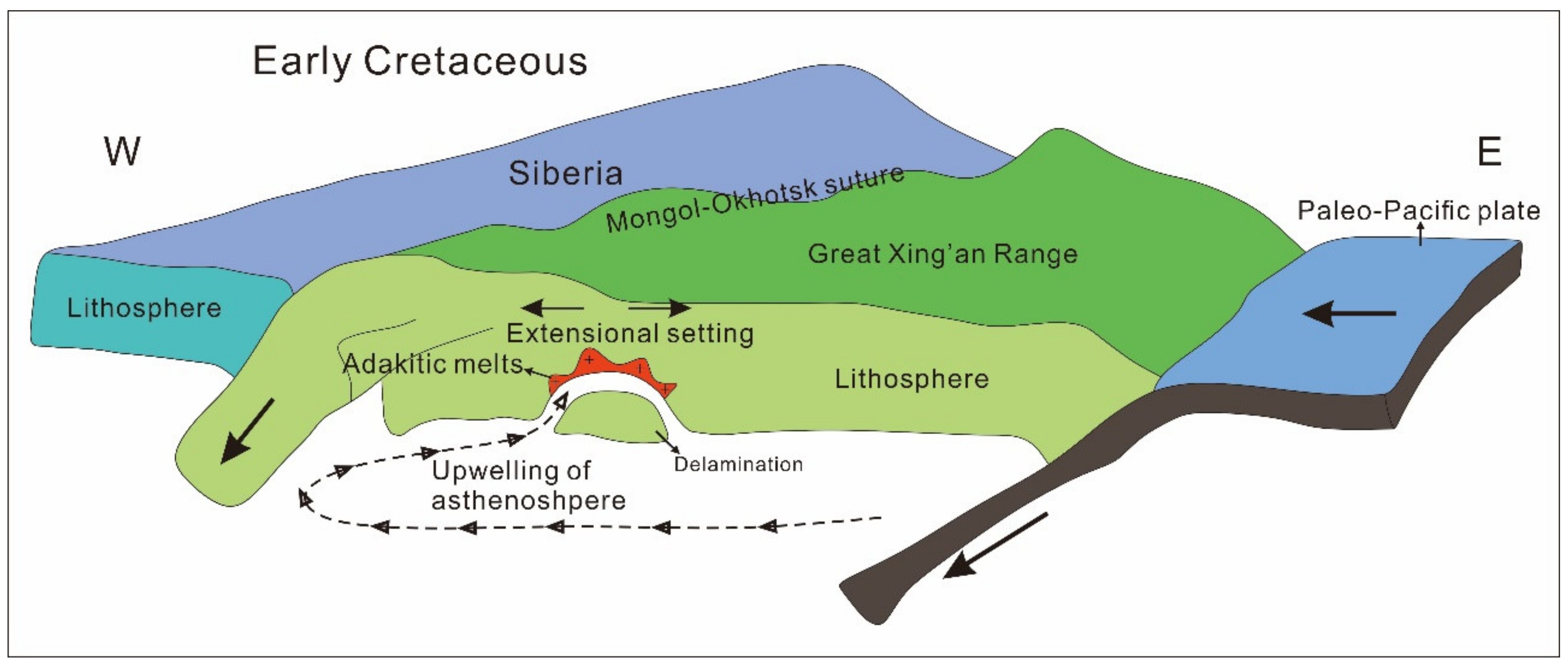
| Intrusive Name | GPS Positions | Lithology | Age (Ma) | (87Sr/86Sr)i | εNd(t) | Reference |
|---|---|---|---|---|---|---|
| Aolunhua | 44°32′ N, 120°13′ E | granitic porphyries | 131.9 ± 0.5 | 0.7021~0.7074 | from −2.9 to 2.5 | [13] and this study |
| Banlashan | 44°06′ N, 120°02′ E | granodiorite porphyry | 133.5 ± 1.7 | - | - | [16] |
| Shabutai | 44°20′ N, 119°01′ E | monzogranite | 138.4 ± 1.5 | 0.7051~0.7058 | from −2.4 to −3.0 | [17] |
| Haisugou | 44°18′ N, 119°03′ E | granite | 137.6 ± 0.9 | 0.7040~0.7074 | from 0.2 to 1.6 | [14] |
| Yangchang | 43°32′ N, 119°05′ E | monzogranite | 137.4 ± 2.1 | 0.7043~0.7056 | from −1.5 to −2.0 | [15] |
| Huanggang | 43°35′ N, 117°29′ E | granite | 136.7 ± 1.1 | 0.7021~0.7073 | from −0.8 to 0.9 | [18] |
| Xiaodonggou | 43°01′ N, 117°44′ E | porphyric granite | 142.0 ± 2.0 | 0.7050~0.7055 | from −2.4 to −2.8 | [19] |
| Rock Type | Granitic Porphyry | |||||||||||
|---|---|---|---|---|---|---|---|---|---|---|---|---|
| Sample No. | ALH-03 | ALH-07 | ALH-12 | ALH-13 | ALH-15 | ALH-16 | ALH-17 | ALH-18 | ALH-21 | ALH-22 | ALW-07 | ALW-14 |
| Major element oxides (wt. %) | ||||||||||||
| SiO2 | 66.81 | 69.20 | 66.34 | 72.16 | 70.00 | 67.64 | 68.58 | 69.24 | 71.09 | 67.28 | 66.84 | 68.93 |
| Al2O3 | 15.53 | 13.96 | 16.13 | 12.79 | 14.32 | 15.92 | 15.62 | 15.78 | 12.85 | 14.33 | 15.67 | 15.93 |
| Fe2O3T | 2.26 | 1.51 | 2.51 | 1.48 | 1.71 | 2.45 | 2.24 | 2.16 | 2.49 | 1.46 | 3.40 | 1.36 |
| CaO | 1.85 | 1.70 | 2.53 | 1.75 | 2.11 | 2.42 | 2.27 | 2.43 | 2.02 | 2.62 | 2.26 | 2.06 |
| MgO | 0.85 | 0.7 | 0.95 | 0.63 | 0.75 | 0.87 | 0.80 | 0.82 | 0.71 | 0.62 | 1.04 | 0.65 |
| Na2O | 4.97 | 3.49 | 4.86 | 3.26 | 3.66 | 4.58 | 4.49 | 4.45 | 4.62 | 3.13 | 3.80 | 4.73 |
| K2O | 3.16 | 4.66 | 3.03 | 4.22 | 4.74 | 2.98 | 3.26 | 3.49 | 2.38 | 5.74 | 3.45 | 3.34 |
| TiO2 | 0.44 | 0.34 | 0.52 | 0.32 | 0.40 | 0.48 | 0.43 | 0.44 | 0.49 | 0.48 | 0.55 | 0.38 |
| MnO | 0.05 | 0.05 | 0.02 | 0.04 | 0.03 | 0.03 | 0.03 | 0.03 | 0.10 | 0.03 | 0.04 | 0.01 |
| P2O5 | 0.136 | 0.116 | 0.162 | 0.111 | 0.131 | 0.160 | 0.148 | 0.138 | 0.177 | 0.152 | 0.157 | 0.122 |
| LOI | 2.42 | 2.3 | 1.28 | 1.61 | 0.52 | 1.34 | 0.96 | 0.82 | 2.48 | 2.59 | 1.21 | 0.60 |
| Total | 98.58 | 98.12 | 98.49 | 98.45 | 98.48 | 99.02 | 98.96 | 99.93 | 99.49 | 98.53 | 98.56 | 98.22 |
| K2O + Na2O | 8.45 | 8.51 | 8.12 | 7.72 | 8.57 | 7.74 | 7.91 | 8.01 | 7.22 | 9.25 | 7.45 | 8.27 |
| K2O/Na2O | 0.64 | 1.34 | 0.62 | 1.29 | 1.30 | 0.65 | 0.73 | 0.78 | 0.52 | 1.83 | 0.91 | 0.71 |
| A/CNK | 1.04 | 1.01 | 1.02 | 0.98 | 0.96 | 1.05 | 1.04 | 1.02 | 0.93 | 0.89 | 1.11 | 1.05 |
| A/NK | 1.47 | 1.22 | 1.58 | 1.22 | 1.22 | 1.62 | 1.53 | 1.50 | 1.44 | 1.12 | 1.60 | 1.50 |
| CaO/Na2O | 0.37 | 0.49 | 0.52 | 0.54 | 0.58 | 0.53 | 0.51 | 0.55 | 0.44 | 0.84 | 0.59 | 0.44 |
| Mg# | 42.69 | 47.87 | 42.84 | 45.74 | 46.48 | 41.29 | 41.43 | 42.92 | 36.09 | 45.68 | 37.73 | 48.63 |
| σ | 2.70 | 2.48 | 2.61 | 1.89 | 2.58 | 2.28 | 2.32 | 2.39 | 1.72 | 3.15 | 2.16 | 2.48 |
| Trace Element (ppm) | ||||||||||||
| Li | 21.5 | 15.5 | 20.9 | 13.3 | 4.83 | 18.1 | 15.5 | 15.7 | 26.3 | 19.5 | 21.4 | 7.16 |
| Be | 3.34 | 3.40 | 4.09 | 3.43 | 4.11 | 2.84 | 3.20 | 3.31 | 3.03 | 4.87 | 3.90 | 3.23 |
| Sc | 4.24 | 2.92 | 4.43 | 2.13 | 2.33 | 3.23 | 3.26 | 3.67 | 4.80 | 3.54 | 3.80 | 2.64 |
| V | 36.7 | 29.4 | 48.0 | 29.4 | 34.3 | 37.2 | 33.8 | 37.1 | 43.7 | 56.0 | 44.6 | 28.5 |
| Cr | - | - | 0.56 | 13.4 | - | - | - | - | 0.65 | 0.73 | 4.35 | - |
| Co | 3.45 | 2.41 | 4.56 | 2.7 | 2.55 | 3.83 | 3.67 | 3.84 | 4.01 | 3.41 | 3.17 | 3.54 |
| Ni | 0.82 | - | 0.74 | 7.24 | - | 0.12 | 0.43 | 0.15 | 0.46 | 1.23 | 1.61 | 0.94 |
| Cu | 92.2 | 45.3 | 634 | 415 | 19.4 | 312 | 23.7 | 37.3 | 186 | 77.1 | 2.29 | 157 |
| Zn | 47.0 | 41.7 | 55.4 | 101 | 18.5 | 67.9 | 39.3 | 21.4 | 201 | 33.3 | 52.7 | 14.8 |
| Ga | 20.7 | 19.2 | 21.8 | 16.9 | 18.9 | 20.1 | 20.3 | 20.4 | 18.0 | 21.0 | 20.1 | 19.7 |
| Ge | 1.00 | 1.08 | 1.32 | 1.37 | 1.78 | 1.10 | 1.20 | 1.29 | 1.04 | 1.76 | 1.06 | 1.31 |
| As | 5.97 | 6.61 | 5.75 | 5.43 | 4.85 | 5.09 | 5.14 | 4.91 | 6.71 | 6.23 | 7.25 | 5.16 |
| Rb | 104 | 131 | 101 | 111 | 109 | 67.4 | 84.3 | 105 | 77.0 | 145 | 103 | 55.6 |
| Sr | 509 | 429 | 809 | 436 | 564 | 677 | 656 | 642 | 362 | 519 | 597 | 620 |
| Y | 9.29 | 7.66 | 8.88 | 7.72 | 8.72 | 9.32 | 9.66 | 9.29 | 10.5 | 9.55 | 10.4 | 9.94 |
| Zr | 111 | 91.1 | 141 | 74.7 | 101 | 120 | 122 | 103 | 138 | 110 | 148 | 105 |
| Nb | 6.64 | 5.42 | 5.97 | 5.01 | 5.69 | 5.88 | 6.10 | 6.04 | 7.80 | 5.44 | 7.37 | 5.49 |
| Mo | 25.1 | 1343 | 12.8 | 3101 | 1434 | 1.75 | 97.1 | 24.8 | 4691 | 456 | - | 4.37 |
| Ag | 1.07 | 0.64 | 5.49 | 5.24 | 0.18 | 1.97 | 0.28 | 0.25 | 6.92 | 1.65 | 0.41 | 0.64 |
| Cs | 5.40 | 4.70 | 4.33 | 2.52 | 1.30 | 2.83 | 2.17 | 1.69 | 3.02 | 3.37 | 5.83 | 0.432 |
| Ba | 648 | 739 | 1020 | 609 | 675 | 784 | 721 | 685 | 547 | 589 | 919 | 670 |
| La | 21.7 | 15.4 | 18.3 | 14.5 | 17.2 | 21.3 | 19.2 | 17.4 | 15.1 | 17.2 | 24.3 | 15.0 |
| Ce | 39.9 | 31.7 | 35.2 | 29.5 | 35.1 | 42.4 | 37.7 | 34.8 | 31.3 | 37.4 | 48.5 | 31.6 |
| Pr | 4.54 | 3.71 | 3.99 | 3.50 | 4.20 | 4.90 | 4.51 | 4.07 | 3.87 | 4.51 | 5.55 | 3.86 |
| Nd | 16.3 | 13.7 | 15.3 | 12.8 | 15.3 | 18.1 | 16.9 | 15.0 | 14.7 | 17.2 | 20.5 | 15.3 |
| Sm | 2.87 | 2.51 | 2.62 | 2.44 | 2.80 | 3.16 | 2.87 | 2.68 | 2.81 | 2.91 | 3.69 | 2.86 |
| Eu | 0.682 | 0.643 | 0.887 | 0.565 | 0.769 | 0.814 | 0.795 | 0.724 | 0.537 | 0.864 | 0.837 | 0.737 |
| Gd | 2.22 | 2.05 | 2.04 | 1.77 | 2.12 | 2.48 | 2.26 | 2.03 | 2.24 | 2.43 | 2.92 | 2.23 |
| Tb | 0.278 | 0.246 | 0.288 | 0.255 | 0.294 | 0.321 | 0.304 | 0.281 | 0.301 | 0.316 | 0.364 | 0.327 |
| Dy | 1.32 | 1.26 | 1.30 | 1.21 | 1.41 | 1.44 | 1.48 | 1.38 | 1.54 | 1.53 | 1.71 | 1.58 |
| Ho | 0.265 | 0.237 | 0.280 | 0.226 | 0.276 | 0.292 | 0.271 | 0.271 | 0.326 | 0.308 | 0.335 | 0.306 |
| Er | 0.745 | 0.673 | 0.769 | 0.603 | 0.736 | 0.763 | 0.731 | 0.734 | 0.820 | 0.852 | 0.920 | 0.826 |
| Tm | 0.098 | 0.096 | 0.105 | 0.084 | 0.106 | 0.106 | 0.095 | 0.097 | 0.119 | 0.121 | 0.121 | 0.113 |
| Yb | 0.670 | 0.644 | 0.698 | 0.540 | 0.745 | 0.735 | 0.694 | 0.691 | 0.805 | 0.797 | 0.950 | 0.781 |
| Lu | 0.106 | 0.093 | 0.107 | 0.081 | 0.108 | 0.108 | 0.088 | 0.101 | 0.110 | 0.116 | 0.136 | 0.109 |
| Hf | 2.36 | 2.16 | 2.80 | 1.74 | 2.48 | 2.79 | 2.53 | 2.33 | 2.94 | 2.33 | 3.52 | 2.40 |
| Ta | 0.411 | 0.351 | 0.335 | 0.319 | 0.399 | 0.378 | 0.369 | 0.399 | 0.601 | 0.325 | 0.601 | 0.394 |
| W | 4.41 | 4.07 | 16.2 | 97.8 | 15.8 | 4.28 | 9.71 | 11.8 | 13.3 | 297 | 2.22 | 5.14 |
| Tl | 0.675 | 0.617 | 0.476 | 0.489 | 0.265 | 0.335 | 0.296 | 0.315 | 0.512 | 0.506 | 0.917 | 0.172 |
| Pb | 8.28 | 9.91 | 12.9 | 206 | 5.15 | 8.36 | 8.01 | 6.23 | 226 | 19.9 | 9.00 | 6.62 |
| Th | 4.59 | 3.85 | 2.99 | 3.90 | 3.94 | 4.24 | 4.19 | 4.81 | 5.78 | 3.22 | 8.10 | 4.23 |
| U | 1.62 | 2.61 | 1.39 | 1.44 | 1.61 | 1.06 | 1.78 | 1.98 | 1.94 | 1.62 | 2.30 | 1.35 |
| ΣREE | 91.70 | 72.96 | 81.88 | 68.07 | 81.16 | 96.92 | 87.90 | 80.26 | 74.58 | 86.55 | 110.83 | 75.63 |
| LREE | 85.99 | 67.66 | 76.30 | 63.31 | 75.37 | 90.67 | 81.98 | 74.67 | 68.32 | 80.08 | 103.38 | 69.36 |
| HREE | 5.70 | 5.30 | 5.58 | 4.77 | 5.79 | 6.24 | 5.92 | 5.59 | 6.26 | 6.47 | 7.45 | 6.27 |
| LREE/HREE | 15.07 | 12.78 | 13.67 | 13.28 | 13.01 | 14.52 | 13.84 | 13.36 | 10.91 | 12.38 | 13.87 | 11.06 |
| La/Yb | 32.39 | 23.91 | 26.22 | 26.85 | 23.09 | 28.98 | 27.67 | 25.18 | 18.76 | 21.58 | 25.58 | 19.21 |
| δEu | 0.83 | 0.87 | 1.17 | 0.83 | 0.97 | 0.89 | 0.95 | 0.95 | 0.65 | 0.99 | 0.78 | 0.89 |
| δCe | 0.99 | 1.03 | 1.01 | 1.02 | 1.01 | 1.02 | 0.99 | 1.01 | 1.00 | 1.04 | 1.02 | 1.02 |
| Sr/Y | 54.73 | 55.93 | 91.02 | 56.40 | 64.61 | 72.57 | 67.84 | 69.04 | 34.59 | 54.28 | 57.62 | 62.31 |
| Rb/Sr | 0.204 | 0.306 | 0.125 | 0.255 | 0.193 | 0.100 | 0.129 | 0.164 | 0.213 | 0.280 | 0.173 | 0.090 |
| Zr/Hf | 47.03 | 42.18 | 50.36 | 42.93 | 40.73 | 43.01 | 48.22 | 44.21 | 46.94 | 47.21 | 42.05 | 43.75 |
| Nb/Ta | 16.14 | 15.44 | 17.82 | 15.71 | 14.26 | 15.57 | 16.54 | 15.14 | 12.99 | 16.73 | 12.27 | 13.95 |
| Y/Ho | 35.07 | 32.33 | 31.73 | 34.17 | 31.61 | 31.93 | 35.66 | 34.29 | 32.07 | 31.02 | 30.91 | 32.49 |
| TZr (°C) | 787 | 791 | 855 | 840 | 814 | 814 | 804 | 794 | 784 | 742 | 801 | 779 |
| Sample No. | Rb | Sr | 87Rb/86Sr | 87Sr/86Sr | 2sigma | (87Sr/86Sr)i | εSr(t) | Sm | Nd | 147Sm/144Nd | 143Nd/144Nd | 2sigma | (143Nd/144Nd)i | εNd(t) | T2DM(Ma) |
|---|---|---|---|---|---|---|---|---|---|---|---|---|---|---|---|
| ALH-07 | 131 | 431 | 0.879370 | 0.707139 | 0.000005 | 0.705489 | 16.27 | 2.51 | 13.7 | 0.110758 | 0.512470 | 0.000002 | 0.512374 | −1.88 | 1068 |
| ALH-12 | 101 | 811 | 0.360271 | 0.705979 | 0.000004 | 0.705303 | 13.62 | 2.62 | 15.3 | 0.103522 | 0.512492 | 0.000002 | 0.512403 | −1.33 | 1019 |
| ALH-17 | 84.3 | 658 | 0.370615 | 0.705812 | 0.000004 | 0.705117 | 10.98 | 2.87 | 16.9 | 0.102664 | 0.512491 | 0.000003 | 0.512402 | −1.33 | 1019 |
| ALH-20 | 71.0 | 469 | 0.437960 | 0.706470 | 0.000004 | 0.705648 | 18.53 | 1.95 | 11.1 | 0.106201 | 0.512440 | 0.000002 | 0.512348 | −2.39 | 1107 |
| ALH-21 | 77.0 | 364 | 0.611998 | 0.706735 | 0.000005 | 0.705587 | 17.65 | 2.81 | 14.7 | 0.115559 | 0.512418 | 0.000005 | 0.512318 | −2.98 | 1160 |
| ALH-22 | 145 | 521 | 0.805196 | 0.706992 | 0.000005 | 0.705481 | 16.15 | 2.91 | 17.2 | 0.102278 | 0.512440 | 0.000003 | 0.512352 | −2.32 | 1099 |
| ALW-07 | 103 | 599 | 0.497474 | 0.706726 | 0.000004 | 0.705793 | 20.57 | 3.69 | 20.5 | 0.108820 | 0.512612 | 0.000002 | 0.512518 | 0.92 | 839 |
| ALW-14 | 55.6 | 622 | 0.258592 | 0.706014 | 0.000007 | 0.705529 | 16.83 | 2.86 | 15.3 | 0.113004 | 0.512442 | 0.000002 | 0.512344 | −2.46 | 1117 |
© 2020 by the authors. Licensee MDPI, Basel, Switzerland. This article is an open access article distributed under the terms and conditions of the Creative Commons Attribution (CC BY) license (http://creativecommons.org/licenses/by/4.0/).
Share and Cite
He, X.; Tan, S.; Liu, Z.; Bai, Z.; Wang, X.; Wang, Y.; Zhong, H. Petrogenesis of the Early Cretaceous Aolunhua Adakitic Monzogranite Porphyries, Southern Great Xing’an Range, NE China: Implication for Geodynamic Setting of Mo Mineralization. Minerals 2020, 10, 332. https://doi.org/10.3390/min10040332
He X, Tan S, Liu Z, Bai Z, Wang X, Wang Y, Zhong H. Petrogenesis of the Early Cretaceous Aolunhua Adakitic Monzogranite Porphyries, Southern Great Xing’an Range, NE China: Implication for Geodynamic Setting of Mo Mineralization. Minerals. 2020; 10(4):332. https://doi.org/10.3390/min10040332
Chicago/Turabian StyleHe, Xiaohu, Shucheng Tan, Zheng Liu, Zhongjie Bai, Xuance Wang, Yuchao Wang, and Hong Zhong. 2020. "Petrogenesis of the Early Cretaceous Aolunhua Adakitic Monzogranite Porphyries, Southern Great Xing’an Range, NE China: Implication for Geodynamic Setting of Mo Mineralization" Minerals 10, no. 4: 332. https://doi.org/10.3390/min10040332
APA StyleHe, X., Tan, S., Liu, Z., Bai, Z., Wang, X., Wang, Y., & Zhong, H. (2020). Petrogenesis of the Early Cretaceous Aolunhua Adakitic Monzogranite Porphyries, Southern Great Xing’an Range, NE China: Implication for Geodynamic Setting of Mo Mineralization. Minerals, 10(4), 332. https://doi.org/10.3390/min10040332






